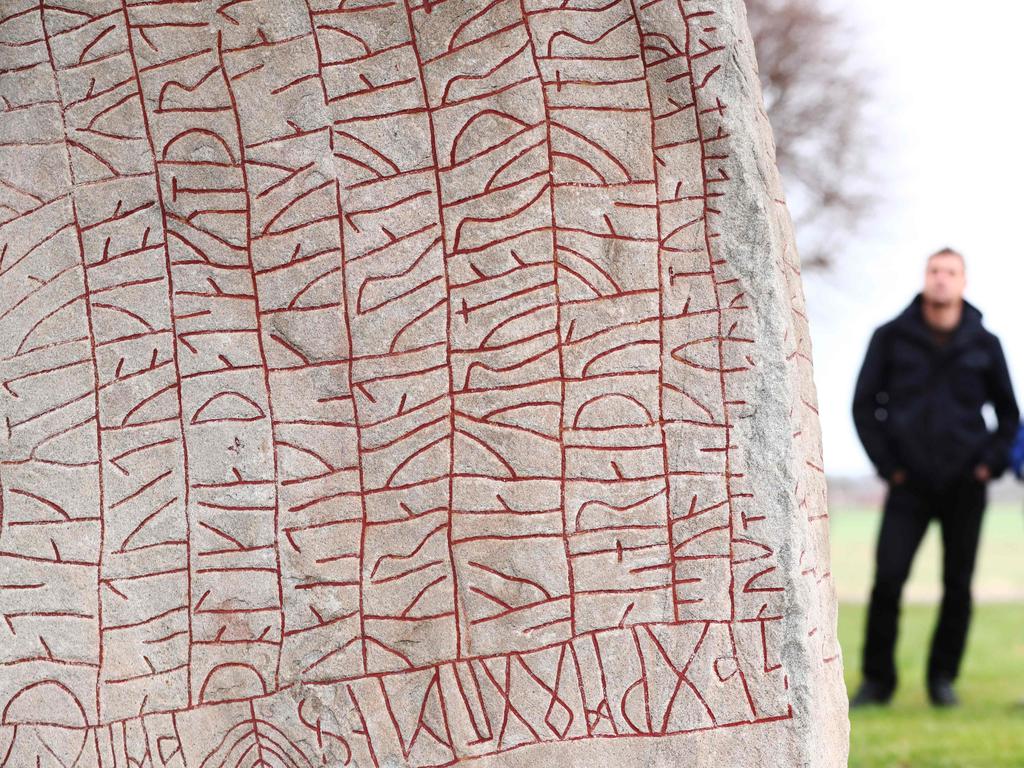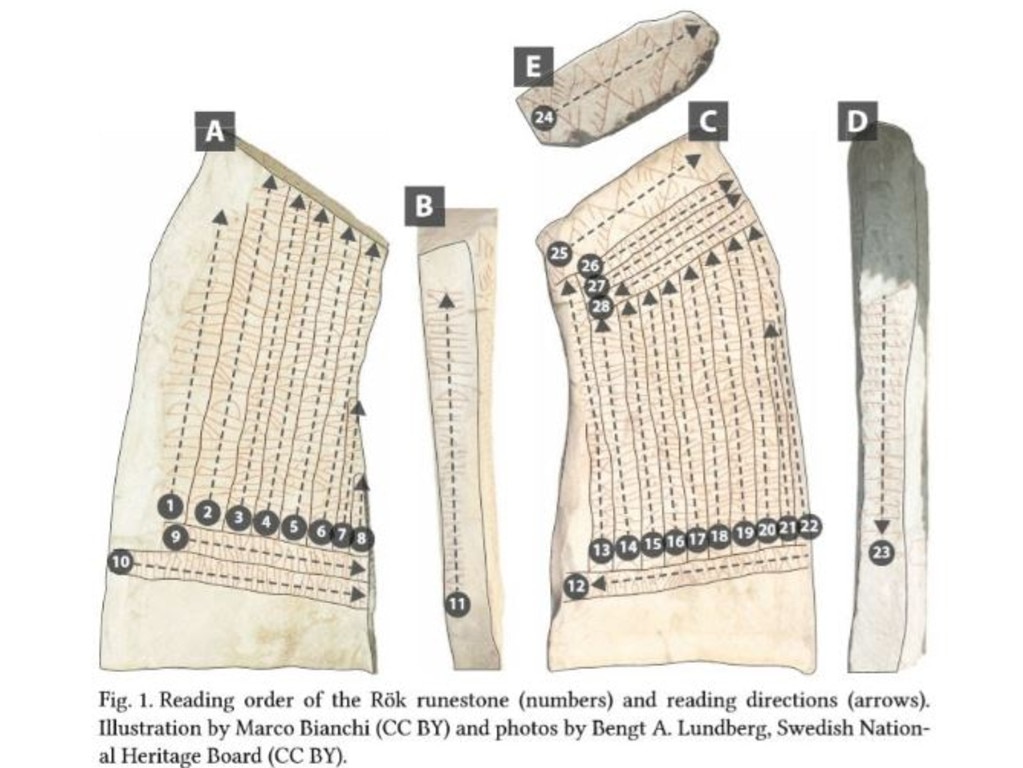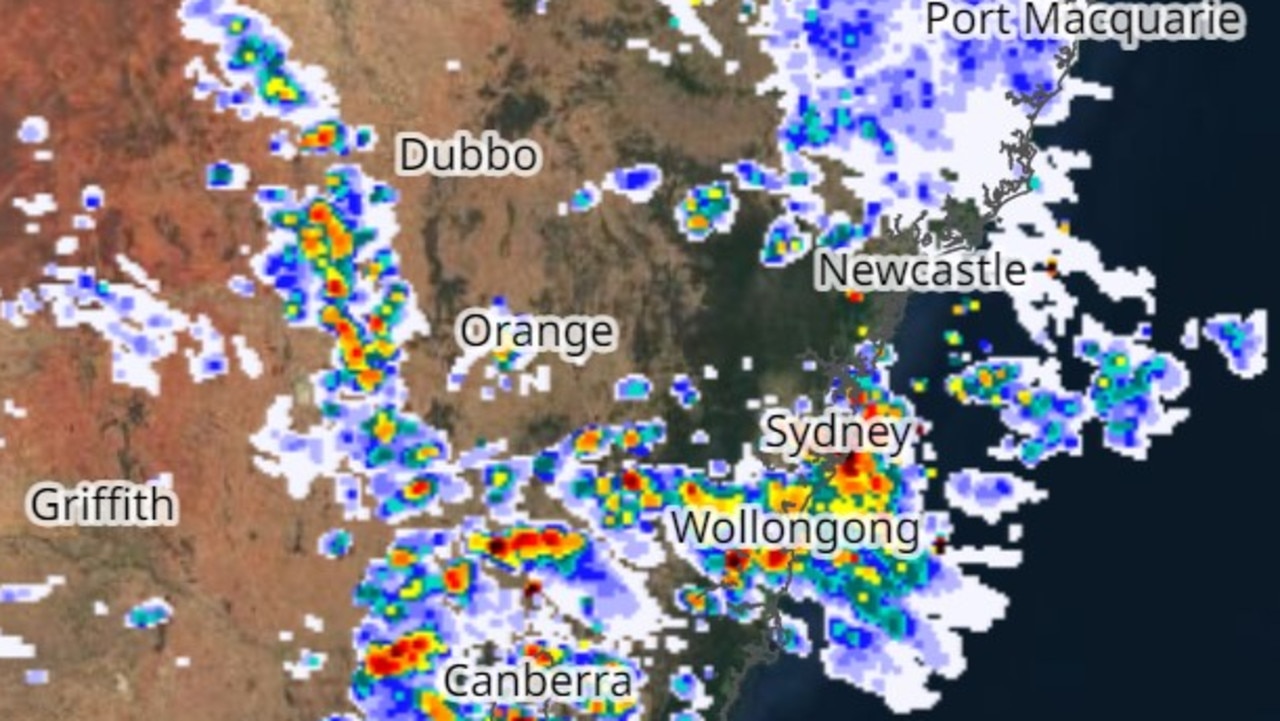‘A coded warning’: 1200-year-old Viking stone reveals chilling prophecy
A secret code that remained unsolved for 1200 years has finally been cracked – and its reveals a dark prophecy that is already coming true.
This 1200-year-old Viking runestone carries a warning.
It’s a monument to a son, fallen in battle. But its coded text tells of a terrible threat to come.
It’s a 2.5m high, five-ton granite slab, deeply inscribed with Viking runes.
For centuries, the monolith lay hidden as a loadstone in a Swedish Östergötland countryside church wall. But, in 1862, renovation workers discovered it had inscriptions on five sides.
Now known as the Rök Runestone (Rökstenen), it turned out to be the oldest of its type. Also the longest.
Historians have been puzzling over the meaning of its 725 Norse characters ever since.
We know it was a eulogy, erected by a grieving Viking father. Did it also boast of his son’s heroic lineage? Was it a record of great battles?
Yes. And no.
The stone enigmatically talks of conflict “between light and darkness, warmth and cold, life and death.” But its runes aren’t ordinary. They are encrypted, making the words seem disjointed and out-of-place.
Whoever had the Rökstenen engraved didn’t want just anyone to read it.
It was a message of terror.
It was a reminder of a cataclysmic past.
It was a warning of the terrible power of climate change.

SIGNS AND PORTENTS
A diverse research team led by Professor Per Holmberg at the University of Gothenburg has attempted to crack a series of nine riddles listed on the stone.
In the process, they claim to have uncovered what may be an ominous prophecy.
Their findings have been published the science journal Futharc: International Journal of Runic Studies.

Like other attempts to solve the Rökstenen code, they had a few clues to start with.
A Viking named Varin raised the stone in honour of his son, Vamoth, at some time around 800AD. This was in the depths of Europe’s Dark Age. And Varin feared things were going to get much darker.
Let’s say this, who, nine generations ago, lost life to the East but still reigns?
The bold warrior, the men’s chief, rode on the horse across the horizon to the east.
Now sits, the foremost of the famous, equipped on his horse with the shield prepared.
This refers to Theodoric the Great, a ruler of the Ostrogoth tribe who took advantage of the collapsing Roman empire to establish himself as emperor of the West. He died in AD526, about 300 years before the Rökstenen was raised.
Why was Theodoric mentioned at all? Why refer to a death nine generations (300 years) earlier?
The researchers believe Dark Age Europe regarded Theoderic’s reign as an omen of the immense calamity that followed his death: A spate of volcanic eruptions covered Europe in darkness for several years. There were terrible storms. Crops failed. Disease spread.
AD536 became known as “the worst year to be alive” as the ash cloud accelerated the demise of the Roman Empire.
Recent studies have found Scandanavia suffered particularly grievously at this time: up to 50 per cent of the region’s population starved or fled. And the tribulations of this era – the trigger of Europe’s Dark Age – were burnt into Viking lore that lingered for generations.

RAGNAROK RISES
Varin had cause for concern. He had witnessed three dramatic events - all of which were harbingers of doom.
“Before the Rök Runestone was erected, a number of events occurred which must have seemed extremely ominousm,” says study author Bo Gräslund.
“A powerful solar storm coloured the sky in dramatic shades of red, crop yields suffered from an extremely cold summer and later, a solar eclipse occurred just after sunrise. Even one of these events would have been enough to raise fears of another Fimbulwinter.”
Eclipses and extreme winters featured prominently in Norse mythology: In particular, they were part of the tale of Ragnarok – a cataclysmic battle of the gods prophesied to bring about the end of the world.
Ragnarok told of the giant wolf Fenrir swallowing the Sun. In the process, the sky turned blood-red and sunlight “black” – and humanity fought a valiant last stand for survival.
Varin, it seems, linked his son’s death to the signs he had seen in the sky.
“The inscription deals with anxiety triggered by a son’s death and the fear of a new climate crisis similar to the catastrophic one after AD536,” the study’s authors write.
Varin was anxious about his position in Viking society. Chiefs were believed to be the spiritual guardians of good harvests.
“They were the leaders of the cult that held together the fragile balance between light and darkness. And finally, at Ragnarök, they would fight alongside Odin in the final battle for the light,” says history professor and study co-author Olof Sundqvist.

WRIT IN STONE
Nine riddles form the core of the Rök Runestone inscription. Seven have answers.
Mostly, the riddles appear to reference battles. But they aren’t the usual Viking boasts about heroic deeds.
Let us say this as a memory for Odin, which spoils of war there were two, which twelve times were taken as spoils of war, both from one to another?
The answer reads: “The Sun and Moon”.
The Sun is also the answer to four of the other riddles. The remaining four talk of the Old Norse God Odin and his band of warriors.
The study finds several aspects of these enigmatic inscriptions have parallels with other Old Norse texts. Not the famous tales of heroes and kings. But, rather, texts that grapple with the big questions of existence and the will of the gods.
These were often riddles.
The researchers say they now believe the Rök stone runes refer to a titanic struggle with the weather.
Battle was how Varin related to his worst nightmare. And the signs in the sky were scarily similar to those in the terrible tales he had heard as a child.
If the Sun lost its power, so would the Viking elite.
“It is suggested that particular riddles for the inscription are linked to contemporary phenomena (a solar storm that coloured the sky red, an extremely cold winter and a solar eclipse) which may have created concern that the sun would lose its power,” the researchers conclude.
Viking chief Varin feared the return of the climate cataclysm that had wrought so much havoc just 300 years earlier.
So he set his warning in stone.
AN ANCIENT CHALLENGE
The Rök Runestone enigma remains unsolved. This is just the latest of several attempted interpretations.
Previous readings place it as a tribute to ancient heroes and battles. But exactly which ones – if any – remains uncertain.
So the freshly revealed parallels with Norse mystic poetry certainly opens up new realms of possibility.
But, like the mysterious quatrains of Nostradamus, the inscriptions remain purposefully vague, poetic - and confusing.
“The enigmatic questions, the intricate cryptograms, and the labyrinth reading order made the monument a challenge for a select few, and a potential place for their enlightenment,” the study says.
The Rökstenen’s author probably intended to test its readers. The poetry was specifically written for those of high status and education. But much of that knowledge has since been lost, which leaves the text open to interpretation.
“The key to unlocking the inscription was the interdisciplinary approach. Without these collaborations between textual analysis, archaeology, history of religions and runology, it would have been impossible to solve the riddles of the Rök runestone,” Professor Holmberg says.

THE ROKSTENEN RIDDLES
The following is the latest Rök stone text translation, and the answer to the nine riddles explained with their textual parallels in Old Norse or Anglo-Saxon poetry. English translation of the inscription: CC-BY Henrik Williams, Per Holmberg, Bo Gräslund, Olof Sundqvist
After Vamoth stand these runes. And Varin, the father, made them after the death-doomed son.
Let us say this as a memory for Odin, which spoils of war there were two, which twelve times were taken as spoils of war, both from one to another?
Answer: The Sun and the Moon
Interpretation: Riddle 29 in the Exeter book: The monthly battle between the sun and the moon over the lunar light
This let us say as second, who nine generations ago lost the life in the east but still decides the matter?
Ride the horse did the bold champion, chief of men, over the eastern horizon. Now he sits armed on his horse, his shield strapped, foremost of the famous.
Answer: The Sun
Interpretation: Vafthruthnismal 46–47: The wolf kills the sun after it has given birth to a new sun. Vafthruthnismal 11–12: The rise of the sun is a ride. Grimnismal 38: The sun has a shield
Let us say this as a memory for Odin, who because of a wolf has suffered through a woman’s sacrifice?
Answer: The Sun
Interpretation: Vafthruthnismal 46-47: The wolf kills the sun
This let us say as twelfth, where the wolf sees food on the battlefield, where twenty kings lie?
Answer: On the battlefield of Ragnarok
Interpretation: Vafthruthnismal 17–18: The last struggle on the battlefield
This let us say as thirteenth, which twenty kings were on the vast battlefield, of four names, born of four brothers? Five Valkis, sons of Rathulf, five Hraithulfs, sons of Rogulf, five Haisls, sons of Haruth, five Gunnmunds, sons of Bern.
And for Odin a memory … (partially unreadable)
Answer: The warriors of Odin
Interpretation: Vafthruthnismal 40-41: The warriors of Odin practice for Ragnarok. Grimnismal 23: The warriors of Odin meet the wolf. Eiriksmal 7–9: Five kings accompany King Eirik to the battle against the wolf.
Let us say a memory for Odin, dare!
[Who is] a protector of sanctuaries for a brother?
Answer: The Sun
Interpretation: Vafthruthnismal 22–23: The brother of the sun is the moon. Lausavísa by Skúli Þorsteinsson: At the setting of the sun it retires to its sanctuary
[Whom] does the wolf redden with blood?
Answer: The Sun
Interpretation: Vafthruthnismal 46–47: The wolf kills the sun. Voluspá 41: The wolf reddens the abodes of the gods with blood
Let us say a memory for Odin to the young man, to whom is born an offspring? It is not a lie.
Answer: Odin
Interpretation: Voluspá 55: Odin’s son Vithar
[Who] could beat a giant? It is not a lie.
Answer: Vithar
Interpretation: Vafthruthnismal 52–53: Vithar kills the wolf. Voluspá 55: Vithar kills the wolf and restores balance.
Clash!
Jamie Seidel is a freelance writer | @JamieSeidel



